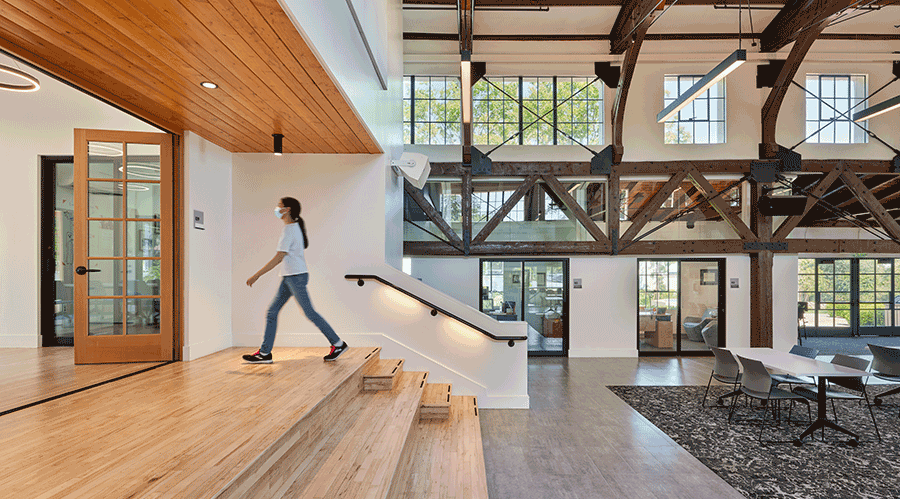Five Wireless Networking Pitfalls
Installing a wireless network requires the attention — and cooperation — of facility and IT executives
By Brandon Lorenz, Senior Editor
While wireless technology can be more convenient for end users, bringing the technology into a facility can pose challenges for facility executives. Building material selection, for example, can inhibit the transmission of wireless signals. Access points are often installed in difficult-to-reach places to prevent tampering. Avoiding five common mistakes can help a wireless installation proceed smoothly, regardless of project size.
Mistake No. 1:
Poor Project Coordination
In many companies, the responsibility of installing a wireless network is handled jointly by the IT and facility departments. IT departments are tasked with managing a wireless network, while the facility department is often expected to assist with the installation of access points throughout the building.
Trouble can develop quickly if the partners are not communicating appropriately before a project begins. “The level of communication really varies from organization to organization,” says Steve Falkin, principal with Baker Robbins Technology Consultants. “I don’t know if it is a turf thing, but IT and facilities management tend to bump heads or be wary of each other sometimes.”
Wireless access points are typically installed above ceilings to prevent tampering. That can mean power cables and conduit need to be installed above ceilings. “That has to be very well coordinated with the facility department to ensure adequate preparation of the space,” says Falkin. Poor coordination could mean that no consideration is given to routing power for the access points, which could delay the project. Or an IT department may not realize that access points in a ceiling may require plenum-rated enclosures. That could cause complications or delays when it comes to finding enclosures for the access points.
“We certainly don’t see facility personnel delving deeply into the bits and bytes of IT, nor would we want an IT person to get involved in the building side of it,” Falkin says. “There is a happy medium. You need to define your parameters so the groups can work well together.”
Mistake No. 2:
Not Planning for the Future
As the technology has matured, wireless access points have become more affordable. Access points can be had for around $300, says Craig Mathias, principal, Farpoint Group. Centralized control makes it easier to administer wireless networks. But that does not mean facility executives should be on autopilot when it comes time to install a wireless network.
“You are going to get one shot to disturb the business operation,” says David Heckaman, principal, Heckaman Group. “Whatever you do, you want to make sure it is as future-proof and robust as possible.”
That means paying attention to current and future needs. Perhaps a company is planning to install an 802.11 wireless network in its offices to carry data to support mobile workers. Does the building also have a need to support in-building cellular coverage? If so, other wireless options, such as a distributed antenna solution, may be appropriate.
The Institute of Electrical and Electronics Engineers (IEEE) assigned wireless networking standards the 802.11 label. Specific standards are identified by a letter, such as 802.11g, a popular wireless standard for computers.
In some cases, it might be appropriate to create a steering committee to examine a company’s need, says Heckaman. Such a committee can look beyond an IT or facility team to what end users need. If a company is losing business because in-building cellular coverage is poor, for example, cellular coverage may need to be added.
“What you should do is survey your users,” says Mathias. “How many do you have? What kind of traffic do they require? How much data? What time of day? Then you can decide where to put the access points.”
Another important planning tool is a radio frequency (RF) survey. Such a survey can predict how a wireless network will function in a particular building by analyzing blueprints and furniture. The survey can then predict where access points will be needed, says Falkin. Such a survey can be especially useful in large, multistory network installations.
An RF survey may not always be required, Mathias says, particularly if the wireless network is small — an office space on one floor, for example. In such a case, access points can be installed with relatively little trouble because most open office plans don’t have problems with radio wave propagation.
Mistake No. 3:
Skimping on the Bandwidth
Regardless of the needs of the facility, it is important to optimize for bandwidth, not for coverage, says Mathias. In the past, many facilities installed wireless networks by trying to spread the access points as far apart as possible to increase coverage. While it increased the number of users, it also slowed the network, because as a user’s distance from an access point increases, the speed of the wireless connection decreases.
“Think what happens when the network is slow,” he says. “You are trying to get your job done and you are sitting there waiting. An individual’s time is a perishable commodity and you either take advantage of it or you don’t.”
Mathias advises his clients to avoid skimping on a wireless network. Bandwidth will easily be eaten up as the mission of a wireless network grows. Developing technologies such as wireless voice-over-IP, for example, will likely add to the demand. Wireless voice-over-IP technology allows normal telephone calls to be transmitted wirelessly over a network. Unlike other uses, data from a wireless voice-over-IP call has a greater need to be sent over the network in the proper sequence, or users will complain of garbled calls. This can place a bigger demand on the wireless network.
Mistake No. 4:
Picking the Wrong Consultant
For some companies lacking the internal resources, it may make sense to retain a wireless consultant to implement the network installation. When searching for wireless consultants, find out what projects they have worked on and contact the companies involved to see if the work was completed satisfactorily, Heckaman says.
Additionally, it’s important to match corporate needs with a consultant’s capabilities. Some companies, for example, operate around the clock. Will a consultant be available to troubleshoot problems that occur late at night? What kind of response time can they offer if a problem occurs?
Mistake No. 5:
Forgetting About Security
Maintaining security on a wireless network is a very different task then protecting a traditional network. Anyone with a laptop computer can logon to an open wireless network, if they are in range of the signal. Once on the network, a rogue user could potentially tamper with corporate data or threaten the reliability of the network.
Configuring security incorrectly is common, says Mathias. “Anybody with an open wireless network is asking for trouble,” he says. “Especially in business.”
Among the steps needed to secure a wireless network: user identities need to be created before guests or employees can logon to the network. In addition, users should sign an acceptable-use document, and the wireless network should be limited so it does not extend beyond a building. Be aware that unauthorized access points can sprout up as building occupants seek to boost network coverage. Unauthorized access points should be immediately removed because they are often unsecured and allow public access to the network.
Much of the job of wireless security falls to an IT department. But the potential for damage if security is breached can be great, and no one wants to be part of a team that puts business continuity at risk.
Consequently, facility executives who are participating in a wireless installation should not ignore the issue, says Falkin. “I think as an educated and enlightened participant, if for some reason IT is not doing what it needs to for security, facility executives can say, ‘Let’s talk about this. What is our security? How do we make sure it’s working appropriately?’”
Related Topics:











